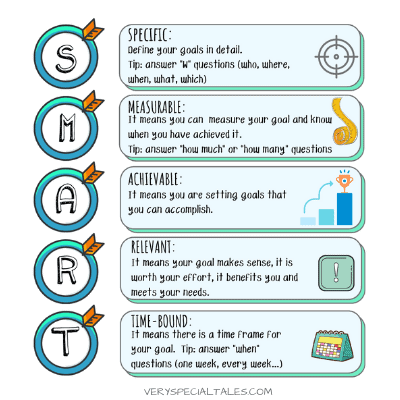
SMART Goals Worksheets & Examples (PDF): Fun SMART Goals for Kids
SMART Goals Worksheets & Flashcards: in this post, you will find examples and definitions of SMART goals for your kids or students. You can download your free SMART goals flashcards and worksheets at the end of this post.
Setting goals and sticking to them is an important life skill that our children will need to acquire.
When we think goal-setting, SMART goals are one of the first things that come to mind.
And for a good reason.
It is a clever mnemonic rule that captures some essential principles for effective goal setting.
What is a SMART Goal?
SMART is an acronym and mnemonic device coined by Professor Robert S. Rubin to simplify the teaching of goal-setting principles.
SMART stands for:
- S- Specific
- M- Measurable
- A- Attainable
- R- Relevant
- T-Time-bound
These principles apply to any goal we want to achieve: academic goals, classroom goals, personal goals, achievement goals, behavior goals.
Benefits of SMART Goal Setting
Teaching your students or children how to set goals following these principles will help them:
- Set meaningful goals
- Improve their chances to persevere and achieve them
- Feel motivated towards achieving their objectives
- Self-manage
How to Teach SMART Goals to Kids
The following tips and examples will help you teach SMART goals to your kids.
Remember you will be able to download SMART goals worksheets at the end of this post.
What are Specific Goals?
Non-specific goals are ambiguous. We don’t know what we need to achieve.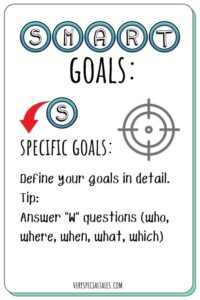
But, how can we teach a child what a specific goal is?
The five Ws are a good start.
The five Ws are questions that help us gather basic information.
Let’s define our goals by answering some of the following questions:
- Who
- Where
- When
- What
- Which
Specific Goal Example
Unspecific Goal: I will clean up my room
Specific Goal: I (Who) will put my toys (What) in the basket (Where) before going to bed (When)
What Are Measurable Goals?
Measurable means that we can quantify our goals. When you can measure a goal, you can also:
When you can measure a goal, you can also:
- track your progress
- know when you have met your goal.
How can we help our kids set measurable goals?
Our goals need to answer “How Much” or “How Many” questions
Measurable Goal Example
Non-Measurable Goal: I will read more.
Measurable Goal: I will read 15 minutes every day.
What are Attainable Goals?
An attainable goal is a goal that we can achieve. 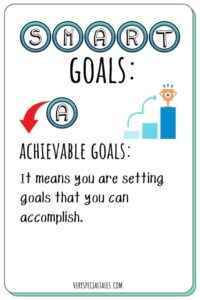
We may need to make an effort and work hard but it is a realistic goal.
Attainable is the original term in this acronym.
Still, your child may understand this better if you use the term “Achievable Goal” (that’s the term I’ve used in the SMART Goals Worksheet PDF that you can download at the end of this post).
A goal that is too difficult to achieve will result in failure, and your child may lose motivation, feel frustrated, or, worse, feel tempted to “fake” the results.
Attainable Goal Example
Unattainable Goal: I will win the school swimming competition (let’s imagine your child is far from being the fastest swimmer on the team)
Attainable Goal: I will improve my freestyle record by 5 seconds in the school swimming competition
What Are Relevant Goals?
Relevant goals are goals that align with your child’s interests and values.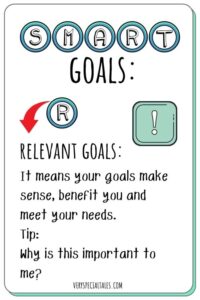
Explore with your child why specific goals are important to them.
If the goal they choose is intended to make you happy, or they feel pressured to do it, they will be relying on external motivators and not what really matters to them.
It will be more difficult to persevere towards their goals when they respond to:
- Social pressure
- Other peoples expectations
Meaningful goals will keep them motivated.
Relevant Goal Example
Let’s assume your child loves writing but is not big on gymnastics (no matter how much you loved it at school).
Non-Relevant Goal: I will join the gymnastics team
Relevant Goal: I will join the creative writing club at school
What are Time-Bound Goals?
Time-bound means there is a time frame for your child’s goal. 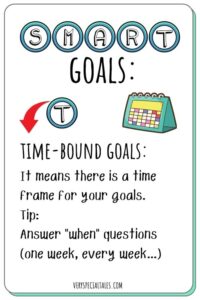
Can you think of how many things you wish to do that you never start because you have not established a deadline for it?
A time frame helps us stay focused.
A helpful tip for your child is that their goals should answer the question “When”.
Time-Bound Goal Example
Unspecified Goal: I will practice my times tables.
Time-bound Goal: I will practice my times tables 10 minutes every weekday.
SMART Goals Worksheet & Flashcards
Download your free SMART Goals for Kids PDF (link below)- it includes:
- Child-friendly SMART Goals definition
- SMART Goals Examples
- Blank SMART Goals worksheets
- SMART Goals Flashcards for Kids
Tip: Goal setting is just the first step. Help your child create a good action plan that allows them to stay focused and achieve their goals (there is a link to some additional goal-setting resources at the end of this post).

Other Interesting Educational Worksheets and Resources
- Goal-Setting Activities for Kids: Goal Ladders, Goal Planner, Goal Tracker
- Anger Signs Worksheets
- Coping Skills Cards
- Emotions- Facial Expression of Emotions
